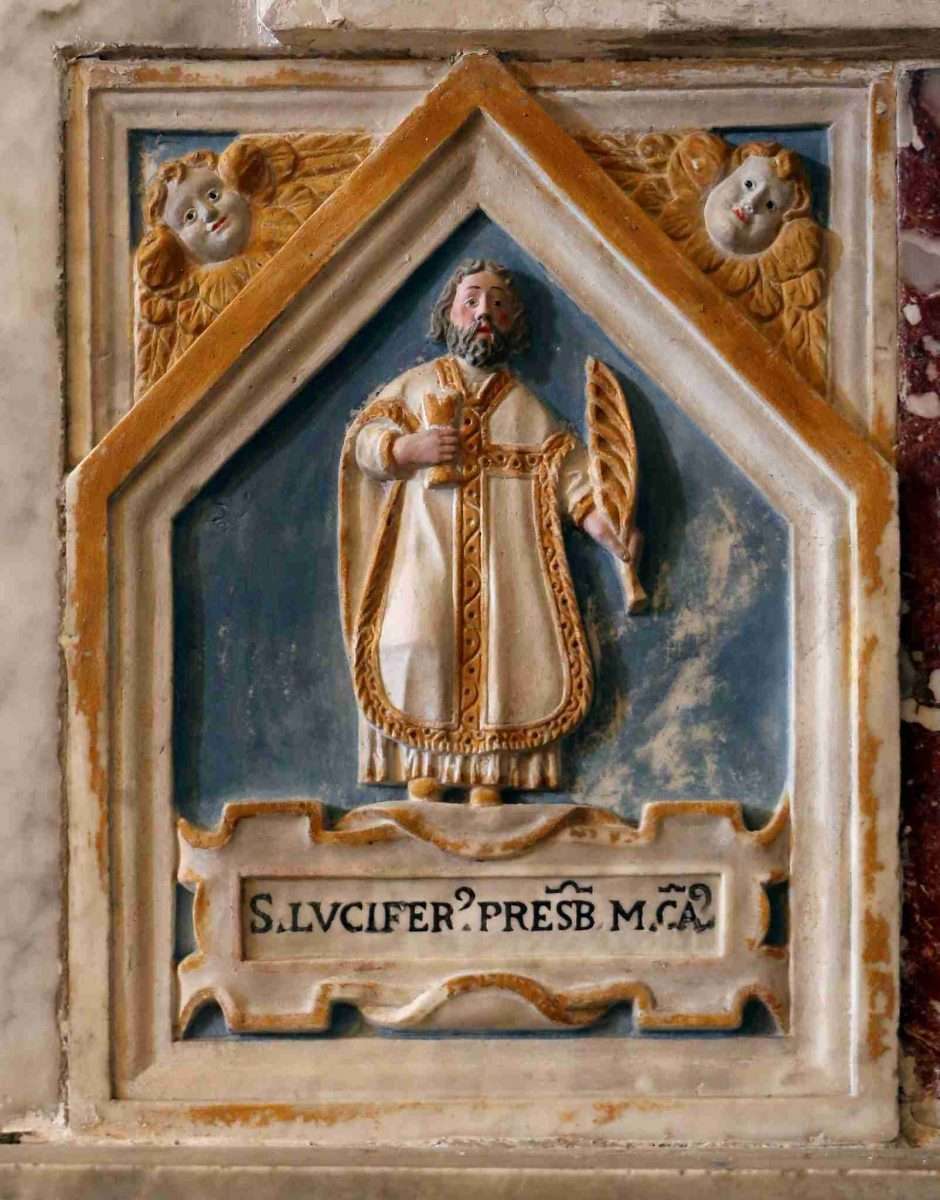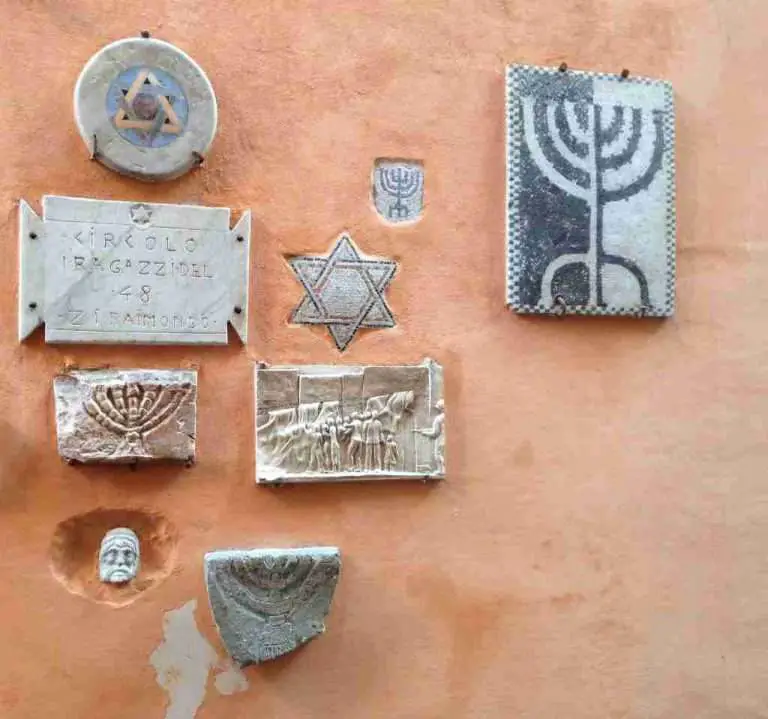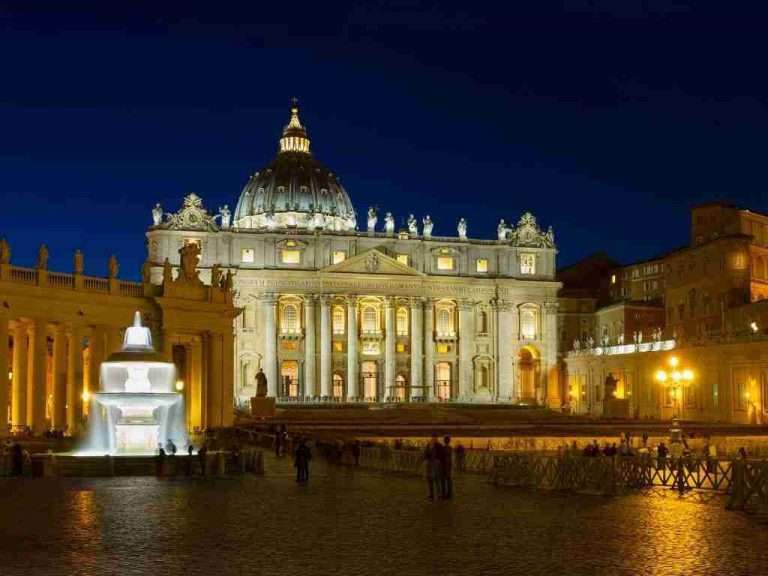
Occasionally while doing research, I come across a factoid that I just have to explore further. This is how I came to learn that there was an ancient bishop named Lucifer who is venerated in Cagliari, Sardinia.
Short History of Lucifer of Cagliari
Lucifer, known as Lucifer Calaritanus in Latin, was born in Cagliari in the 3rd or 4th century and died in 370. His feast day is celebrated in Sardinia each year on May 20.
As a representative of Pope Liberius, Lucifer attended the Synod of Mediolanum (Council of Milan) in 355. There he defended Athanasius, the Bishop of Alexandria, who had been condemned for his opposition to Arianism. “Arian theology holds that the Son of God is not co-eternal with God the Father and is distinct from the Father (therefore subordinate to him).” Accounts of Lucifer’s speeches at the Council of Milan say that he was “vehement” and “ferocious” in his arguments.

Constantius II, son of Constantine the Great and the Roman emperor at the time of the Council of Milan, was a supporter of the Arian doctrine. He rejected Lucifer’s intransigence against the ecclesiastical policies of the empire and sent him and like-minded bishops east into exile. Lucifer lived in Germanica (an area in modern-day Turkey), Palestine, and Egypt, where he continued to write five harsh polemical tracts against Arianism and Emperor Constantius. Concerning Athanasius: Why No One Must Judge or Condemn a Man in His Absence is the only one of these texts that has yet been translated into English.
Lucifer was able to return to Sardinia in 362 following the death of Constantius. Here he continued his preachings against Arianism and in favor of a more orthodox reading of scripture. He served as Bishop of Cagliari until his death in 370.
The Name Lucifer
How is there a saint named Lucifer, the moniker that many Christians use interchangeably with satan? Turns out that Lucifer was not an uncommon name in Roman times and his mention in the Bible was somewhat of a misunderstanding.
Lucifer in Latin means “light-bringer” (lux + ferre) and the name was associated with the planet Venus—the morning star and signal of the dawn. The first bishop of Siena was also named Lucifer.
Lost in Translation
Scholars point to Saint Jerome, who translated the Bible into Latin from the original Hebrew and Ancient Greek, for associating the name Lucifer with the devil. In the Vulgate Bible, Jerome translated the Hebrew “hêylêl” to lucifer (light-bringer).
Jerome used the word lucifer but not the proper name Lucifer. Many modern translations have even reverted back to using “morning star” in the translation of the following passage from Isaiah:
quomodo cecidisti de caelo lucifer qui mane oriebaris corruisti in terram qui vulnerabas gentes.
Isaiah 14:12
Isaiah 14 “contains a taunt (a kind of ancient insult song or poem) against one of the oppressors of Israel: the king of Babylon,” explains Catholic.com. “The king of Babylon fancies himself as something high and mighty—like the Day Star itself—but God brings him low in the end.”

Jerome’s translation was, I imagine, an unfortunate blow to anyone named Lucifer at the time. If you think about it, “light-bringer” and “morning star” are lovely ideas for a name.
But perhaps this translation was not just a misunderstanding. Jerome began his translation of the Bible in 382, or a little over a decade after Lucifer’s death. In the ensuing years, a small cult called the Luciferians formed around the orthodox teachings of Lucifer. In 379—three years before he began his translation project—Jerome wrote his Dialogue Against the Luciferians, in which he mocked Lucifer and his followers:
It happened not long ago that a follower of Lucifer had a dispute with a son of the Church. His loquacity was odious and the language he employed most abusive. For he declared that the world belonged to the devil, and, as is commonly said by them at the present day, that the Church was turned into a brothel. His opponent on the other hand, with reason indeed, but without due regard to time and place, urged that Christ did not die in vain, and that it was for something more than a Sardinian cloak of skins that the Son of God came down from heaven.
Saint Jerome’s Dialogue Against the Luciferians, 379
Philip Schaff explains in his Dictionary of the Bible that “Jerome’s meaning is that Christ came not to win the lowest place on earth, but the highest. The fact that Lucifer was Bishop of Cagliari in Sardinia gives point to the saying.”
Even way back then, people from Sardinia were viewed as different.
Church of Saint Lucifer and His Relics
Lucifer remains a controversial saint and a sort of outcast among certain theologians. Nevertheless, he is still venerated in the place of his birth.

In the early 17th century, Francisco Desquivel, the Spanish Archbishop of Cagliari, sought to renovate the city’s duomo and to move the remains and relics of Cagliari’s Christian martyrs to a central location. In 1623, the remains of Bishop Lucifer were found near the Basilica of San Saturnino, the oldest church in Cagliari.
Lucifer did not die a martyr. But his remains, along with many others, were transferred to an underground crypt in the Duomo of Cagliari. The Sanctuary of the Martyrs (Santuario dei Martiri) contains 179 niches and three chapels—Chapel of Mary of the Martyrs, Chapel of San Saturnino, and Chapel of San Lucifero.


The Chapel of Saint Lucifer contains 80 niches, including the bones of Lucifer. Also in the chapel are a Roman sarcophagus containing the bones of Saint Antiochus and the 19th-century white marble tomb of Maria Giuseppina di Savoia, wife of King Louis XVIII of France.
In addition to the Chapel of Saint Lucifer, Cagliari also has a small 17th-century church that bears the name of the saint. But the cult of Saint Lucifer does not appear to be that strong in the Sardinian capital.

On the other hand, the tiny town of Vallermosa, approximately 18 miles (30 km) northwest of Cagliari, celebrates the former bishop on his feast day. For several days leading up to May 20, Vallermosa celebrates the Festa di San Lucifero with religious ceremonies and processions through the town with the trunk of Saint Lucifer (Truncu de Santu Luzzifuru, in Sardo). All of the festivities culminate at the Church of Saint Lucifer, which dates from the mid-17th century. This video gives you a sense of what the feast day looks like in Vallermosa.
Last updated on August 29th, 2022Post first published on May 20, 2021





![Gabbiano Azzurro Hotel & Suites: Sardinian Style in Golfo Aranci [Review]](https://www.italofile.com/wp-content/uploads/Pool-Terrace-Gabbiano-Azzurro-Sardegna-scaled-768x512.jpg)
